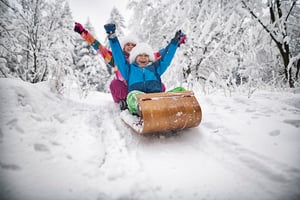 Sledding with friends and family is a great way to enjoy the outdoors. Not to mention, walking up the hill after an exhilarating ride down is a way to get some exercise during winter. However, if you’re not careful, sledding can cause serious injuries. Most injuries are a result of colliding with objects or other people.
Sledding with friends and family is a great way to enjoy the outdoors. Not to mention, walking up the hill after an exhilarating ride down is a way to get some exercise during winter. However, if you’re not careful, sledding can cause serious injuries. Most injuries are a result of colliding with objects or other people.
Many years ago, on winter break, I took my daughter sledding. We jumped onto our tube and down the hill we went. It was fast and we were having so much fun. What I didn’t realize at the time was how fast it can turn into a scary situation. On one of our runs down, we hit a large bump which sent us tumbling. As it was happening, everything seemed to be in slow motion. Next to me, my daughter was tumbling head over heels like a rag doll. At the end of the tumble, we lay there a bit dazed and confused. Luckily, we were both ok. Unfortunately, it put an end to our fun day. On occasion, my daughter still mentions it.
Here are some sledding injury statistics:
- Each year, approximately 20,000 children are injured and require medical care.
- Head injuries are the most common.
- Children 14 and younger are the ones most likely to be injured.
- Sleds can reach speeds of up to 25 miles per hour.
To keep your family safe, check out the safety tips below:
1. Go with your kids.
If you have a hill near your house, you may be tempted to send them on their way. I’d recommend going with them. Even if you don’t sled, you can keep an eye on potentially harmful things they’re unaware of. And in the event of an injury, you’ll be there to help. If you have kids who are five or younger, it’s recommended that you sled with them.
2. Pick the perfect hill.
As a kid, I remember sledding on just about any hill I could find. As a parent, I now realize the importance of checking out the hill ahead of time. Avoid sledding in areas with trees, fences, poles, or rocks. Remember, kids feel invincible and are looking for a thrill. They’re not paying attention to the hazards that could cause injuries. Also, avoid hills that are near streets or busy parking lots.
3. Consider visiting a ski hill.
Some ski hills offer tubing lanes for those seeking speed and family fun. There are many benefits to tubing at a local ski hill such as:
- The tube lanes are designed for safety.
- Shelters can provide a place to warm up or rest.
- Beverages and food are available.
- Staff is available to assist with minor injuries.
- There are lights for tubing at night.
- There may be a track or lift system for taking you up to the starting point.
4. Invest in a good sled.
Tubes and saucers are popular choices for many. They’re affordable and readily available. However, spending money on a sled with steering and braking capabilities is a better option. Back in the day, my brother and I had sleds with these capabilities. Not only did we feel cool, but they also kept us safe. We were able to steer around dangerous objects and avoid other sledders. In addition, we could slow our speed to stop quickly. Don’t forget to check the recommended age on the package before buying.
5. Talk to your kids about safety.
Here are some guidelines to discuss before you go:
- Never go down the hill headfirst.
- Never go down a hill backward or while standing.
- Avoid building a jump or ramp.
- Always keep arms and legs inside the sled.
- Walk up the side of the hill to avoid being struck by other sledders.
6. Buy your kids helmets.
A winter sports helmet is a wise investment and can be used for many outdoor activities. Consider wearing one yourself if you plan on sledding with them.
7. Wear appropriate winter clothing.
If you have a teenager who’s going sledding, they’re likely not dressed appropriately for winter conditions. Make sure your family wears hats, gloves/mittens, snow pants, boots, and winter jackets. In addition, moisture wicking clothing can help keep them warm and dry. Lastly, avoid wearing scarves and other loose clothing that can get caught.
8. Stay hydrated.
Staying hydrated during winter activities is very important. Dehydration can happen quickly in cold weather because your body works hard to keep warm. Check out “8 Tips for Hydrating in Cold Weather.”
Do you have any suggestions or information you’d like to share? I’d love to hear from you. Please share them in the box below.
Source:





